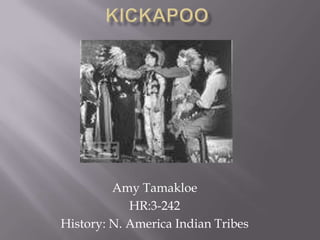
Kickapoo Presentation
- 1. Kickapoo Amy Tamakloe HR:3-242 History: N. America Indian Tribes
- 2. Kickapoo Tribe Kickapoo comes from Kiwigapaw, meaning he stands about, Or he moves about, standing now here, now there. The Kickapoo was generally a tribe that had more people called “Algonquian” but was soon divided into “Foxes”, “Sauks”, and “Kickapoo”. The Kickapoo’s were located in the Northeast of America (in the following states Connecticut, Delaware, District of Columbia, Maine, Maryland, Massachusetts, New Hampshire, New Jersey, New York, Pennsylvania, Rhode Island, and Vermont).
- 3. What was your pre-Colombian groups government structure? Kanakuk was a Kickapoo prophet. When the Kickapoo in 1819 extended their lands, covering nearly half the state of Illinois, they could not go to the land that was meant to be theirs to them in Missouri because the hostile, Osage tribe still remained on that land. Half the tribe left instead to Spanish territory in Texas, and the rest of the Osage tribe was ready to follow when the Government of their own tribe came along, forcing them to leave and go to Missouri. Kanakuk decided that his tribe didn’t need to force another tribe out of their own land he believed that if his tribe did good deeds like, living worthily, not abandoning their native superstitions, avoiding fights among themselves and inputs of the white man's law, and also resisting the seduction of alcohol they would inherit more land that had less to no enemies. Doing this he earned the respect of other disciples from other tribes like the Potawatomi (from Michigan). He was made their chief based on how he presented himself. Their tribe was moved to Kansas, but still followed the same rituals. Sadly he died of the “Smallpox”.
- 4. What were the religious practices and who did they worship and what were some of the religious festivities)? What were the religious practices? They smoked peace pipes with the tabacco. Who did they worship and what were some of the religious festivities? The kickapoo worshiped spirit beings or shamans, which are spirit being there to help individuals and keep things stable and secure. The great man was creator, rely heavily on spirits of 4: winds, sun, moon, earth. Tobacco and thunder were very important in religious system and were used as vision quest for young males in early days. (Public rituals oriented toward seasonality).
- 5. $Kickapoo Economy$ The Kickapoo did many things to obtain their own wealth and feeding of their own, like hunting and gathering adaptation with less favored horticultural activity. Deer and bison were the major sources of meat, but other animals, such as bear, elk, and small animals, were also used. Wild plants and nuts were also picked. The beans and pumpkins were planted in the spring. In the time of European contact, the Kickapoo became involved in the fur trade and later dealt in other goods as well, becoming known as shrewd traders. At this time they did not have paper currency.Kickapoo made their wealth based on trading what they have for what they need.
- 6. Kickapoo Art Kickapoo crafters were known for their pottery, quillwork, and woodcarving. Most eastern Indians like the Kickapoos also made wampum out of white and purple shell beads (Wampum beads were traded as a kind of currency), but they were more culturally important as an art material. The designs and pictures on wampum belts often told the story of an important incident or represented a person's family. After moving south, some of these traditional arts disappeared also with other arts like beadwork and silverwork. Kickapoo Dance: http://www.youtube.com/watch?v=kqJavcRER4Q
- 7. Kickapoo Architects Kickapoo homes, before the 17th century, were either wigwams in the winter or their rectangular wooden houses in the summer. By the 1800s, Kickapoo in Kansas, Oklahoma, Texas and Mexico were living in wickiups along with other tribes in the southwestern and western part of the United States. Wickiupswere usually between 10 to 16 feet in diameter and large enough to house a single family unit. Kickapoo homes in the summer in the Great Lakes area were usually about 12 by 20 feet with walls about 7 feet high and the roof peaking at 13 feet tall. Once they moved south, wickiups were about 8 feet in diameter and 7 feet tall in the central domed area.